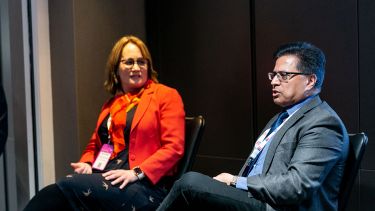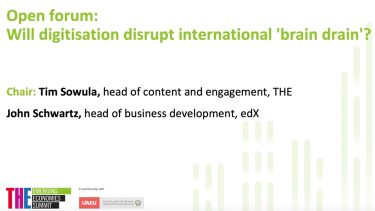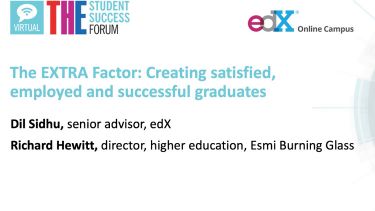Challenges presented by student mobility can be mitigated by building a community online, as skills and modular learning become increasingly important
Blended learning will become the “new normal” for universities and students, who are already embracing the greater flexibility it offers, according to a panel discussion at the Times Higher Education Student Success Forum 2020.
The session explored how institutions can adapt to the new learning landscape and maintain learning continuity and student success in the coronavirus era.
When Houston-based Rice University cancelled in-person classes in March, the institution spent 13 days training more than 130 teaching staff in online delivery.
“The rest of the semester was delivered remotely and we learned a lot in that process,” said Caroline Levander, its vice-president for global and digital strategy. “One thing we learned was that we needed to do it better.”
The university’s entire summer course schedule was restructured for online delivery. Tuition fees were also reviewed to encourage more students to take summer classes.
“By the end of summer session, half our undergraduate students had successfully taken a Rice course fully online, from the first day of class to the final exam,” Levander added.
Anant Agarwal, founder and CEO of digital learning platform edX, said that the company launched edX Online Campus in response to the global demand for quality learning opportunities in the face of worldwide campus closures. edX offered its courses free to higher education institutions over the summer and continues to provide online content and platform solutions as universities adapt to new instructional models. As part of this environment and calls for more flexible, on-demand learning, Agarwal predicted that demand for modular credentials would increase. For example, leveraging short course content to provide students with additional professional certificates as part of their degree.
“They are getting employable skills and credentials that not only enhance their experience but also give them value as they’re going through university,” he said.
At Rice, students “really relished” the greater flexibility offered by online learning. “I think greater student mobility is going to be both an opportunity and a challenge,” Levander predicted.
“I can imagine a future where students will want to take Rice courses online while they’re not in Houston or on our campus.”
With a move to online learning, one risk is losing the allure of the on-campus student experience.
“However you deliver your coursework, build community while you do it,” Levander advised. “So much of a college experience is not the classroom so thinking about ways to build a community while students and faculty are remote is really crucial to the dynamism of your campuses.”
Agarwal added that surveys conducted by edX suggested that 70 to 80 per cent of teaching staff viewed the move to online learning positively or neutrally. And students, already digital natives, increasingly demand the flexibility and opportunity provided by access to more dynamic forms of learning.
“For university leaders, my advice would be to seize the moment. Blended learning will become the new normal so online learning and in-person learning will coexist on your campuses.”
Watch the entire discussion above or on the Times Higher Education YouTube channel.
Find out more about edX Online Campus.










